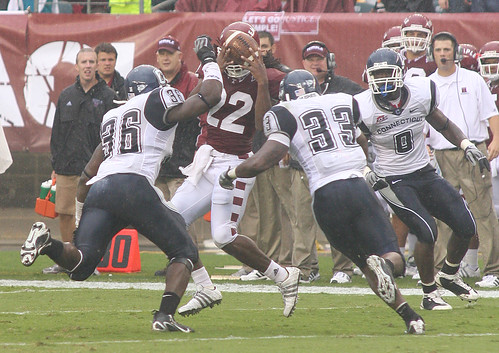For the second year in a row, Temple lost to Connecticut following a controversial ending.
The bigger picture issues, though, were that the Owls didn’t help their cause with eight penalties totaling 85 yards and a run defense that gave up 302 yards on the ground.
With rainy, windy conditions throughout most of the game thanks to Tropical Storm Hanna, handing the ball off to the running back was a lot safer than attempting to throw it through the air and risk a turnover.
UConn tried that in the first half, but its senior quarterback, Tyler Lorenzen, didn’t have a lot of success.
In the second half, the Huskies came out and called 17 of their 34 offensive plays for redshirt junior tailback Donald Brown.
UConn pounded the rock for 174 yards in the first half, and its tactic worked even better after halftime. By the time the game was over, the Huskies had added 128 additional yards to that total.
“You’ve got to give them a lot of credit,” coach Al Golden said. “Obviously their game plan was to run the ball and they did it well. And they’ve proven it over time against good competition. Whoever it was last year, that kid ran the ball like that. And that’s what they’re committed to doing.”
The Huskies were committed enough to hand the ball to Brown 36 times for 220 yards, with Lorenzen accumulating 16 carries and 77 yards of his own.

In last season’s match-up, Brown only rushed for 54 yards, while his team as a whole gained only 156.
But that was against a Temple run defense that ranked No. 3 in the Mid-American Conference last season.
So far this season, that hasn’t been the case.
Army ran through the Owls’ defensive line for 223 yards on 58 carries in the Aug. 29 game.
The Huskies managed 79 more yards on three fewer carries, as Brown became the first Temple opponent to rush for 200 yards or more since Syracuse’s Damien Rhodes accomplished the feat in 2004.
“We were in the right calls,” junior linebacker John Haley said. “I guess a couple guys inside didn’t fill the holes. I know [Brown] was definitely breaking tackles. We just didn’t wrap up like we should have and bring him down. We should have tackled better.”
Haley was one of the bright spots for Temple’s defense. Along with junior middle linebacker Alex Joseph, sophomore defensive back Jaiquawn Jarrett and sophomore linebacker Amara Kamara, Haley was one of four Owls to total double-digits in tackles. He also had an interception, one of two turnovers caused by the Owls in the game.
Last year’s No.1 nationally-ranked redzone defense came through again, too, holding UConn to only two field goals until the game-winning touchdown scored in overtime.
“No matter how we’re playing, when a team gets in the redzone, we do not want them to score,” senior defensive tackle Terrance Knighton said. “We did a good job of executing in the redzone for most of the game. It just fell apart at the end.”
The end of the game was when that defense needed a stop the most, since the offense was only able to put up a field goal in its portion of overtime. Unfortunately, a defense that spent almost 60 percent of the game on the field cracked in the end, allowing Brown to run for 25 yards on three carries and into the end zone for the game-winning score.
“My defense was tired,” Golden said after the game. “But you’ve got to give [UConn] a lot of credit. I can’t say enough about coach D’Onofrio and his staff and what they did on defense, though.”
That defense will need to step up in the upcoming road games against Buffalo and Penn State, lest the high total of rushing yards allowed per game becomes a recurring theme.
Through their teams’ first two games, the Bulls and Nittany Lions are averaging 187 and 286.5 rushing yards per game, respectively.
The Owls’ defense can’t afford to let another opponent run all over them again.
Jennifer Reardon can be reached at jennifer.reardon@temple.edu.



Be the first to comment